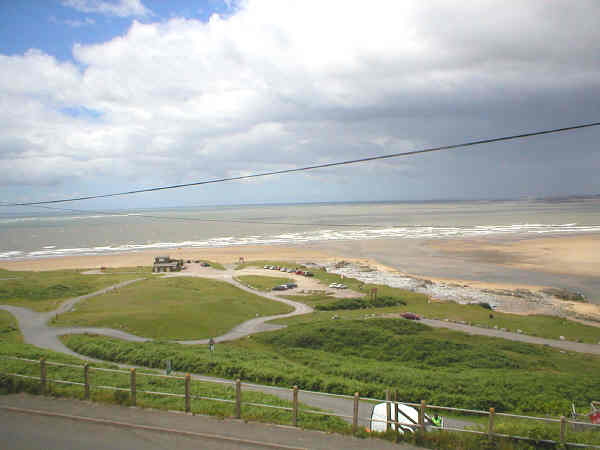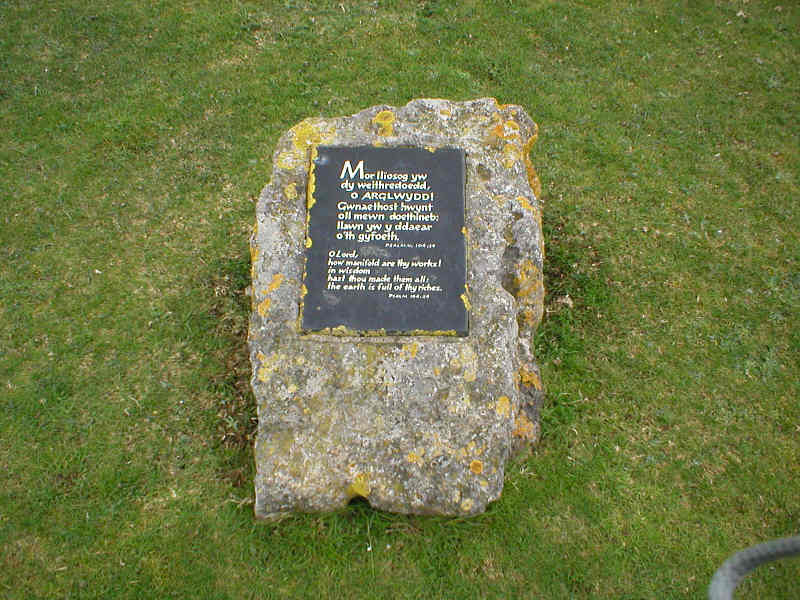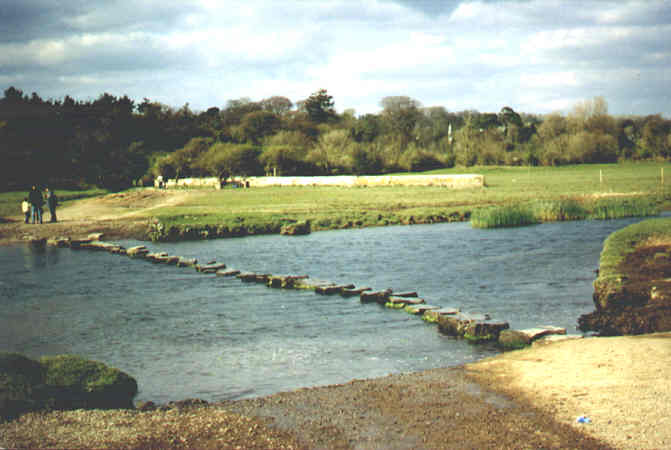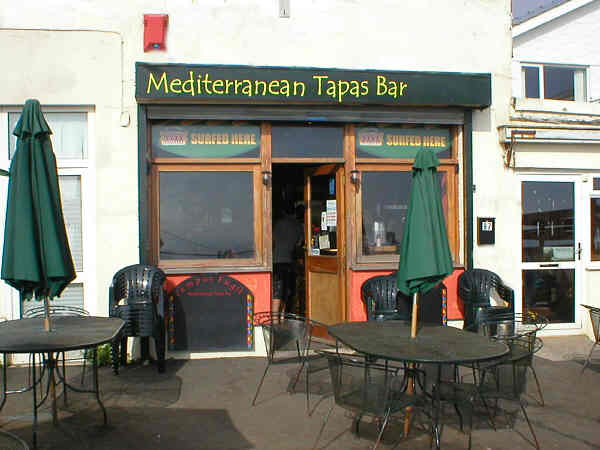|
A Brief History of Ogmore & Ogmore-by-Sea |
Return to main History page
Other History pages: St. Brides
Major | Southerndown |
Ogmore-by-Sea |
Marine | School

Rivermouth beach car parking area surrounded by common land
There were three houses
overlooking
the Bristol Channel and the Somerset/Devon coast in 1840: Sutton Farm House,
Craig-yr-Eos Farm and Sealawn.
Three more buildings were added by 1878: Tusker House, Sealawn Farm and St.
Margarets (this last dwelling is shown on maps of 1860 and situated near Sealawn). By 1918 Sealawn had been
renamed Slon (confusingly, Sealawn Farm was also known locally as Slon) and St. Margarets changed to Brig-y-Don.
Slon reverted to its original name of Sealawn in 1958 and later became
Sea Lawns
Hotel;
situated on Slon Lane, it had a pool table, bar,
Peppers Restaurant,
Gower Suite Function
Room, and nine bedrooms, catering for local clientele and visitors for many years
until its closure in November, 2005; it was demolished in May, 2012.
Craig-yr-Eos Farm was the site of the home of the 15th century
Welsh bard, Iorwerth Fynglwyd. He
was buried in St. Bridget’s Church, St. Brides Major, although it is not known
where his tomb is located. In 1973 the
owners of the Craig-yr-Eos hotel & restaurant bought a 100 ft
log cabin and sun lounge to cater
for large and small functions;
it was designed by Bridgend architects Jenkins and Gould and built in Norway
then taken apart and re-constructed on site; with no nails and hardly any glue,
the structure was
held together by joints. The Craig-yr-Eos was sold and converted into flats
at the end of the 20th century.
Brig-y-Don (used by the Red Cross to house evacuees during the Second World War) was
also a hotel and restaurant for many years then became a home for the elderly,
known as Heritage Coast House, until its closure in 2003; this building was
demolished in early 2004 and a block of luxury apartments built on the site

Plaque in recognition of the outstanding beauty of the area
Prior to 1920, officially there was no such place as Ogmore-by-Sea*
as it was then a part of Southerndown known as Sutton, taking its name from the
celebrated Sutton Stone Quarries. It is claimed that it is the only stone of its kind which can
be sawn when taken from the quarry, and which hardens as it weathers.
The old village school in St. Brides Major was one of the last buildings to use this
material. Alfred Davies, sculptor
and monumental mason, used the last piece quarried from the bottom of
Pant-y-Slade for the First World War memorial stone in St. Bridget’s Church.
Close examination of the font and pulpit reveals numerous small holes
that have been artificially filled because of the presence of small shells or
fossilization in the Sutton Stone. A
block quarried in the middle 1800s (and which still bore the marks of the
original workman’s drill) was found at the old Sawmill at Merthyr Mawr and was
used in 1972 to bear a
plaque in recognition of the outstanding beauty of the
area. Sutton Stone has been used in the Houses of Parliament at
Westminster and the Vatican City in Rome.
* Some early postcards of the area around Craig-yr-Eos
Bay and Rivermouth (circa
1910) can be found marked "Ogmore on Sea" or "Bungalows at Ogmore" and even in
the 1960s some depicted Ogmore Castle and the Pelican Inn as being in "Ogmore-by-Sea,
Southerndown" possibly because this was the location of the local Post Office,
where mail would be sorted.
Ogmore* consisted of thatched cottages
and farms surrounding Ogmore Castle, an Inn, Watermill, Almshouses and some
outlying dwellings.
Ty Maen Farmhouse was
built in 1535. For a year or so until 2005 Ty Maen sold teas and home made cakes; o
Ogmore Castle
Oliver Cromwell is reputed to have laid siege to the
12th century (circa 1116) Ogmore
Castle; if this is so, it was probably at the time of his march on Swansea.
Two Drake Shot of Cromwellian times (circa 1648) have been found – one embedded in
the wall of Ogmore Cottage (next to the Pelican Inn) and the other in a tree in
the garden.
A former outpost of the castle was near Castle-upon-Alun
Farm in the small village of Castle-upon-Alun.
It would have commanded a good view of the valley towards Ewenny.
Early masonry and two archways dating from the 13th and 15th
centuries have been found in a building near the site.
The stepping stones at Ogmore were well known because
it was here that Baptists would celebrate their Baptismal Rites.
A large congregation would gather on the grassy bank surrounding the
ruins of the castle to witness the service which took place in the waters of the
Ewenny River. Candidates were prepared for the ceremony in Star Cottage, then the minister would
wade into the water to the fourth or fifth stone and as they walked
towards him he would immerse them.

Left photo: Stepping stones across the River Ewenny
Right photo: Star Cottage
circa 1947
Star Cottage, a listed building with an unusual feature of a coffin door that was used to avoid the small twisty staircase, was ruined and had its thatched roof destroyed by fire on Friday, 3rd November, 2006. Re-building and re-thatching took place in 2007 to restore this historic landmark.
On the south side of the River Ogmore is a modernised
private dwelling which at one time was the Portobello Hotel.
Many years ago, when walkers returning home found the tide was in, they
would shout to the owner, Mr. Prosser, and he would ferry them across the river
in his little flat-bottomed home-made boat for a small fee.
Both the Portobello and the Pelican Inn sold tokens or
checks which you could exchange for refreshments at a later date.
Workers would purchase as many of these as they could afford so that when
they were short of money at a later date they would still be able to have a
drink. At one time, it was only
possible to buy drinks on a Sunday throughout Wales if you could prove to the
innkeeper that you had travelled three miles or more.
One organisation, the Glamorgan Artillery, had their range near the
Portobello and after practice on a Sunday morning some of the members would
arrive to spend the rest of the day in the hotel as it was the required distance
from Bridgend.
On the common at Rivermouth, one of the dwellings used to house the Sutton Café.
There was also a caf
Mrs Gaudian's Medina Tea Room was in the Nest (or Tuska)
Field, now known as Church Close, situated behind the row of shops. The Nest Caf

Right photo: Tempus Fugit Mediterranean Tapas Bar, Ogmore-by-Sea, in 2005
And don't forget to see the Ogmore-by-Sea picture gallery!!
Other History pages: St.
Brides Major | Southerndown |
Ogmore-by-Sea |
Marine | School
Return to main History page